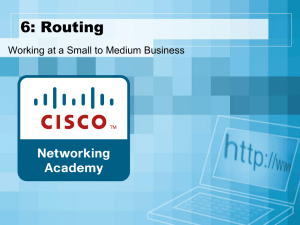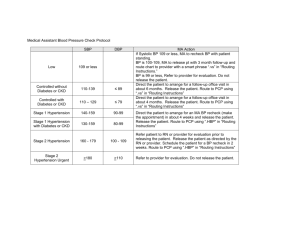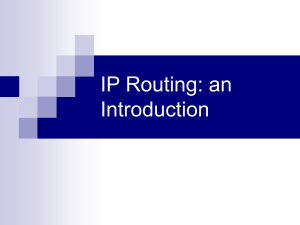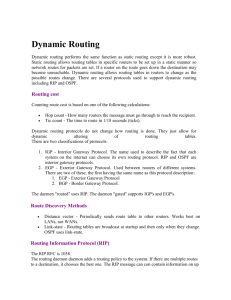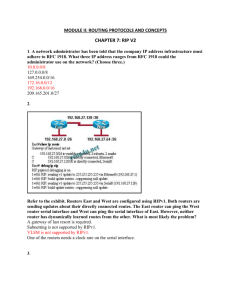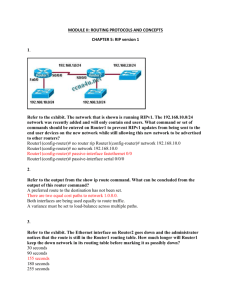Chapter 6-2
advertisement
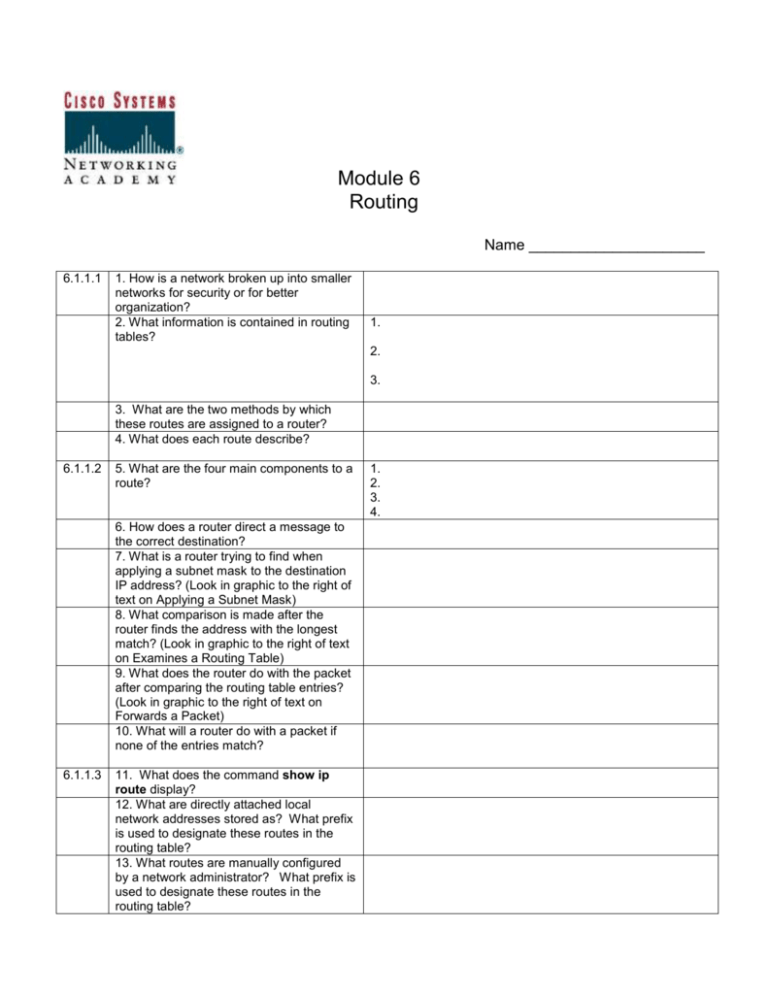
Module 6 Routing Name _____________________ 6.1.1.1 1. How is a network broken up into smaller networks for security or for better organization? 2. What information is contained in routing tables? 1. 2. 3. 3. What are the two methods by which these routes are assigned to a router? 4. What does each route describe? 6.1.1.2 5. What are the four main components to a route? 6. How does a router direct a message to the correct destination? 7. What is a router trying to find when applying a subnet mask to the destination IP address? (Look in graphic to the right of text on Applying a Subnet Mask) 8. What comparison is made after the router finds the address with the longest match? (Look in graphic to the right of text on Examines a Routing Table) 9. What does the router do with the packet after comparing the routing table entries? (Look in graphic to the right of text on Forwards a Packet) 10. What will a router do with a packet if none of the entries match? 6.1.1.3 11. What does the command show ip route display? 12. What are directly attached local network addresses stored as? What prefix is used to designate these routes in the routing table? 13. What routes are manually configured by a network administrator? What prefix is used to designate these routes in the routing table? 1. 2. 3. 4. 14. What are dynamic routes? What prefix is used to designate these routes in the routing table? 15. What is a default route? Where do default routes commonly point to? 6.1.1.4 6.1.2.1 16. If routers do not contain end-to-end information about the entire path from a source network to a destination network, what is contained in the routing table? 17. Complete the commands that are need to configure a default route. 18. Why do larger networks generally use dynamic routing rather than static routes? Complete the PacketTracer on 6.1.1.5. 19. How are routing protocols used by routers? 20. What does dynamic routing help avoid? Router# Router(config)# 21. What is a routing algorithm? 22. What are the two types of routing algorithms? 23. What happens to the routing tables in all the routers when the topology of a network changes because of reconfiguration or failure? 24. What is meant when routers are said to have converged? 6.1.2.2 25. What must happen in order for two routers to exchange routes? 26. What is passed periodically from router to router by a distance vector routing algorithm? 27. What are the two basic criteria on which distance vector algorithms evaluate the route information it receives from other routers? 28. What are six different components that express the distance of a route or the route cost? 1. 2. 3. 4. 5. 6. 29. What is the vector or direction component of a route? 6.1.2.3 30. What does each router that uses distance vector routing communicate? 31. What is the distance from an interface that leads to each directly connected network? CCNA Discovery 2 – Module 6 Dinuba High School Cisco Networking Academy 2 32. What is the best path? 33. When will routing table updates occur? 6.1.3.1 6.1.3.2 Complete the activity on 6.1.2 page 4. Complete Lab Activity on 6.1.2 page 5. 34. What type of routing protocol is RIP? 35. What is the metric used for path selection? 36. What happens if the hop count is greater than 15? 37. How often are routing table updates sent? 38. What does a router do when it receives a routing update that includes a new or changed route? 39. What are triggered updates? 40. What are two advantages that make RIP a widely used and popular routing protocol? 41. What are three disadvantages of RIP? 1. 2. 3. 42. What is the most significant difference between RIP version 1 and 2? 6.1.3.3 43. Since RIPv1 does not send subnet mask information in the updates, what must it rely on? 44. Why was EIGRP developed? 45. Instead of hop count, what metrics does EIGRP use? 46. What are three key characteristics of EIGRP? 47. What two additional database tables are created by EIGRP? 48. What type of data is stored in the neighbor table? 49. What does the topology table contain? CCNA Discovery 2 – Module 6 Dinuba High School Cisco Networking Academy 3 50. What does the Diffused Update Algorithm (DUAL) calculate? 6.1.3.4 6.1.3.5 51. What do link-state routing algorithms maintain? 52. What are link state advertisements (LSA’s)? 53. What is a topological database? 54. What is the SPF (Shortest Path First) algorithm? 55. What happens each time a new LSA packet causes a change to the link-state database? 56. What are 5 key characteristics of OSPF? 1. 2. 3. 4. 5. 6.1.4.1 57. What are three examples of when routers send link state advertisements to each other? 58. Where are “update LSAs” sent when there is a change to the rest of the network? 59. What does OSPF require? 1. 2. 3. 60. List the six metrics used in IP routing protocols. 1. 2. 3. 4. 5. 6. 61. What is the administrative distance (AD)? 62. What does a route with a lower AD than another route indicate? 6.1.4.2 63. Why is it recommended to use only one routing protocol enabled for the entire network? 64. Small networks with only one gateway use what routes? 65. When can RIPv2 be used? 66. When is RIP no longer a good choice as a routing protocol? 67. What routing protocols are commonly used for larger networks? CCNA Discovery 2 – Module 6 Dinuba High School Cisco Networking Academy 4 68. What are the three main criteria in helping settle on a protocol? 1. 2. 3. 6.1.5.1 6.1.5.2 69. When is RIP an appropriate choice as a routing protocol? 70. For the most basic RIP configuration, what are the three commands to remember? 71. What is one method to verify that RIP is functioning properly in the network? Router(config)# Router(config-router)# Router(config-router)# 72. What does the command show ip protocols verify? 6.2.1.1 73. What does the command show ip route show you? 74. What does debug ip rip command allow an administrator to observe? 75. Why should the debug command be used with care in a production network? Complete the PacketTracer on 6.1.5.3. Complete the Lab Activity on 6.1.5.4. 76. What is an autonomous system (AS)? 77. What is an Autonomous System Number (ASN)? 6.2.1.2 6.2.2.1 78. What is the most common example of an AS? 79. The ASN applies to which devices? Complete the activity on 6.2.1 page 3. 80. What is an Interior Gateway Protocol (IGP) used for? 81. What is the purpose of an interior routing protocol? 82. What are “interior routers?” 83. What are three examples of interior gateway protocols? 84. What are exterior gateway protocols (EGP) are designed to do? 85. What does the EGP serves as? CCNA Discovery 2 – Module 6 Dinuba High School Cisco Networking Academy 5 86. What are “exterior routers?” What are exterior routers are also called? 87. What do exterior routing protocols seek to find? 6.2.2.2 6.2.3.1 6.2.3.2 88. What is the most common exterior routing protocol on the Internet today? What is the most current version? 89. How do ASs exchange their “reachability information” with each other? 90. How does a packet eventually arrive at an exterior router at the edge of the local AS? 91. What does the reachability database tell the router? 92. How do exterior gateway protocols help with traffic flow? 93. How do ISPs make sure that the Internet connection for their customers is always available? 94. What is sent if the regular route fails in an ISP? 95. What is local traffic? 96. What is transit traffic? 6.2.4.1 97. Why are many Autonomous Systems not willing to carry transit traffic? 98. When an ISP puts a border router at a customer location, what is it usually configured with? 99. What is the command needed to configure the AS number in order to enable BGP on a router? (Look at the commands in the screen shot example.) 100. What is the command to identify the BGP neighbor router? 101. What is the command to have BGP advertise an internal route? 102. What type of IP addresses are normally used for BGP? Complete the Lab Activity on 6.2.4 page 2. CCNA Discovery 2 – Module 6 Dinuba High School Cisco Networking Academy Router(config)# Router(config-router)# Router(config-router)# 6


